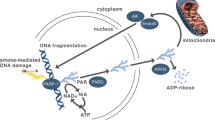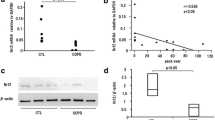Abstract
Although benzene, a well-known human carcinogen, has been shown to induce apoptosis in vitro, no studies have been carried out to confirm and characterize its role in activating apoptosis in vivo. The present study investigated the effects of benzene inhalation on the epithelial cells lining the respiratory tract including bronchioles, terminal bronchioles, respiratory bronchioles and alveoli of male Sprague-Dawley rats. Inhalation of benzene 300 ppm for 7 days induced apoptotic changes in the parenchymal components in the lung that significantly exceeded the events of programmed cell death in normal control tissues. Apoptosis was confirmed by the electrophoretic analysis of internucleosomal DNA fragmentation of benzene-exposed lung tissues, which exhibited 180–200 bp laddering subunits indicative of genomic DNA degradation. Furthermore, semi-quantitative analysis of intracellular localization of terminal deoxynucleotidyl transferase-mediated dUTP-biotin nick end labeling TUNEL) showed a significant (p < 0.001) increase in the apoptotic index calculated for bronchiolar 73.5%, terminal bronchiolar (65%), and respiratory bronchiolar 60.8% segmental epithelial components as well as alveolar (55%) epithelia. Analysis of immunohistochemical expression of apoptosis-related gene products also supported the hypothesis that benzene can induce apoptosis in chemosensitive target cells in the lung parenchyma. Quantitative immunhistochemistry showed a statistically significant increase p < 0.001 in the immunoreactive staining index for cytochrome c, Apaf-1 (apoptosis activating factor-1), DNA fragmentation factor, and representative cysteine proteases including caspase-1, caspase-2L, caspase-8 and caspase-9. Thus this is the first study of the respiratory system that demonstrates that benzene inhalation induces lung cell apoptosis as confirmed by DNA electrophoresis, in situ nick end labeling, and the upregulation of apoptosis-related gene products that facilitate caspase-cleaved enzymes which lead to cell degradation via programmed cell death. These responses may represent an important defense mechanism within the parenchymal cells of the respiratory system that reduce mutational hazard and the potential carcinogenic effects of benzene-initiated pathogenesis.
Similar content being viewed by others
Abbreviations
- Apaf-1:
-
apoptosis activating factor 1
- ISI:
-
immunoreactive staining index
- TUNEL:
-
terminal deoxynucleotidyl transferase-mediated dUTP-biotin nick end labeling
References
Aksoy M. CRC benzene carcinogenicity. Boca Raton: CRC Press; 1988.
Aksoy M. Hematotoxicity and carcinogenicity of benzene. Environ Health Perspect. 1989;82:193–7.
Ashkenazi A, Dixit V. Death receptors: signaling and modulation. Science. 1998;281:1305–8.
Bratton SB, Lau SS, Monks TJ. The putative benzene metabolite 2,3,5-tris(glutathion-S-yl) hydroquinone depletes glutathione, stimulates sphingomyelin turnover, and induces apoptosis in HL-60 cells. Chem Res Toxicol. 2000;13:550–6.
Brown D, Sun X-M, Cohen G. Dexamethosone-induced apoptosis involves cleavage of DNA to large fragments prior to internucleosomal fragmentation. J Biol Chem. 1993;268:3037–9.
Butt A, Harvey N, Parasivam G, Kumar S. Dimerization and autoprocessing of the Nedd2 (caspase-2) precursor requires both the prodomain and the carboxyl-terminal regions. J Biol Chem. 1998;273:6763–8.
Casciola-Rosen L, Nicholson D, Chong T, Rowan K, Thornberry N, Miller D, Rosen A. Apopain/CPP32 cleaves proteins that are essential for cellular repair: a fundamental principle of apoptotic death. J Exp Med. 1996;183:1957–64.
Chang H, Yang X. Proteases for cell suicide: functions and regulation of caspases. Microbiol Mol Biol Rev. 2000;64:821–46.
Coffey R, Watson R, Fitzpatrick JM. Signaling for the caspases: their role in prostate cell apoptosis. J Urol. 2001;165:5–14.
Cryns V, Yuan J. Proteases to die for. Genes Dev. 1998;12:1551–70.
Darrall K, Figgins J, Brown R, Phillips G. Determination of benzene and associated volatile compounds in mainstream cigarette smoke. Analyst. 1998;123:1095-101.
Donepudi M, Sweeney A, Briand C, Grutter M. Insights into the regulatory mechanism for caspase-8 activation. Mol Cell. 2003;11:543–9.
Duan H, Orth K, Chinnaiyan A, et al. ICE-LAP6, a novel member of the ICE/Ced-3 gene family, is activated by the cytotoxic T cell protease granzyme B. J Biol Chem. 1996;271:16720–4.
Eldadah B, Faden A. Caspase pathways, neuronal apoptosis, and CNS injury. J Neurotrauma. 2000;17:811–29.
Fadeel B, Orrenius S, Zhivotovsky B. The most unkindest cut of all: on the multiple roles of mammalian caspases. Leukemia. 2000;14:1514–25.
Goelz, S, Hamilton, S, Vogelstein, B. Purification of DNA from formaldehyde fixed and paraffin embedded human tissue. Biochem Biophys Res Commun. 1985;130:118–26.
Gorman A, Orrenius S, Ceccatelli S. Apoptosis in neuronal cells: role of caspases. Neuroreport. 1998;9: R49–55.
Green D, Reed J. Mitochondria and apoptosis. Science. 1998;281:1309–12.
Grutter MG. Caspases: key players in programmed cell death. Curr Opin Struct Biol. 2000;10:649–55.
Hayes R, Yin S, Dosemeci M, et al. Mortality among benzene-exposed workers in China. Environ Health Perspect. 1996;104:1349–52.
Hiraku Y, Kawanishi S, Oxidative DNA damage and apoptosis induced by benzene metabolites. Cancer Res 1996;56:5172–8.
Hoffman D, Melikian A, Wynder E. Scientific challenges in environmental carcinogenesis. Prev Med. 1996;25:14–22.
Imai Y, Kimura T, Murakami A, Yajima N, Sakamaki K, Yonehara S. The CED-4-homologous protein FLASH is involved in Fas-mediated activation of caspase-8 during apoptosis. Nature. 1999;398:777–85.
Johnson D. Noncaspase proteases in apoptosis. Leukemia. 2000;14:1695–703.
Li H, Bergeron L, Cryns V, et al. Activation of caspase-2 in apoptosis. J Biol Chem. 1997;272:21010–7.
Li P, Nijhawan D, Budihardjo I, et al. Cytochrome c and dATP-dependent formation of Apaf-1/caspase-9 complex initiates an apoptotoic protease cascade. Cell. 1997;91:479–89.
Liu X, Kim C, Yang J, Jemmerson R, Wang X. Induction of apoptotic program in cell-free extracts: requirement for dATP and cytochrome c. Cell. 1996;86:147–57.
Martins L, Mesner P, Kottke T, et al. Comparison of caspase activation and subcellar localization in HL-60 and K562 cells undergoing etoposide-induced apoptosis. Blood. 1997;90:4283– 96.
Moran JL, Siegel D, Sun XM, Ross D. Induction of apoptosis by benzene metabolites in HL60 and CD34+ human bone marrow progenitor cells. Mol Pharmacol 1996;50:610–5.
Pasinelli P, Houseweart M, Brown R Jr, Cleveland D. Caspase-1 and -3 are sequentially activated in motor neuron death in Cu, Zn superoxide dismutase-mediated familial amyotrophic lateral sclerosis. Proc Natl Acad Sci USA. 2000;97:13901–16.
Pinkerton K, Plopper C., Mercer R., et al. Airway branching patterns influence asbestos fiber location and the extent of tissue injury in the pulmonary parenchyma. Lab Invest. 1986;55:688–95.
Plopper C, Dungworth D, Tyler W. Pulmonary lesions in rats exposed to ozone. A correlated light and electron microscopic study. Am J Pathol. 1973;71:375–86.
Plopper C, Hyde D, Weir, A. Centriacinar alteration in lungs of cats chronically exposed to diesel exhaust. Lab Invest. 1983;49:391–9.
Porter AG. Protein translocation in apoptosis. Trends Cell Biol. 1999;10:394–401.
Sakahira H, Enari M, Ohsawa Y, Uchiyama Y, Nagata S. A caspase-activated DNase that degrades DNA during apoptosis, and its inhibitor ICAD. Nature. 1998;391:43–50.
Shu S, Ju F, Fan L. The glucose oxidase-DAB-nickel method in peroxidase histochemistry of the nervous system. Neurosci Lett. 1985;85:169–71.
Snyder R. Overview of the toxicology of benzene. J Toxicol Environ Health. 2000;61:339–46.
Snyder R, Witz G, Goldstein BD. The toxicology of benzene. Environ Health Perspect. 1993;100:293–306.
Stephens R, Sloan M, Evans M, Freeman G. Early response of lung to low levels of ozone. Am J Pathol. 1974;74:31–58.
St. George J, Harkema J, Hyde D, Plopper C. Cell populations and structure/function relationships of cells in the airways. In: Gardiner D, ed. Toxicology of the lung. New York: Raven Press; 1993:81–110.
Strandgaard C, Miller MG. Germ cell apoptosis in rat testis after administration of 1,3-dinitrobenzene. Reprod Toxicol. 1998;12:97–103.
Vojdani A, Mordechai E, Brautbar N. Abnormal apoptosis and cell cycle progression in humans exposed to methyl tertiary-butyl ether and benzene contaminating water. Hum Exp Toxicol. 1997;16:485–94.
Wang J, Lenardo MJ. Roles of caspases in apoptosis, development, and cytokine maturation revealed by homozygous gene deficiencies. J Cell Sci. 2000;113:753–7.
Wyllie A. Apoptosis: cell death in tissue regulation. J Pathol. 1987;153:313–6.
Xerri L, Palmerini F, Devilard E, et al. Frequent nuclear localization of ICAD and cytoplasmic co-expression of caspase-8 and caspase-3 in human lymphomas. J Pathol. 2000;192:194–202.
Yardley-Jones A, Anderson D, Parke D. The toxicity of benzene and its metabolism and molecular pathology in human risk assessment. Br J Ind Med. 1991;48:437–44.
Yeh, H-C, Harkema, J. Gross morphometry of airways. In: Gardiner D, ed. Toxicology of the lung. New York: Raven Press; 1993:55–79.
Yin S, Li G, Tain F, et al. A retrospective cohort study of leukemia and other cancers in benzene workers. Environ Health Perspect. 1989;82:207–13.
Yin S, Hayes R, Linet M, et al. An expanded cohort study of cancer among benzene-exposed workers in China. Benzene Study Group. Environ Health Perspect. 1996a; 104:1339– 41.
Yin S, Hayes R, Linet M, et al. A cohort study of cancer among benzene-exposed workers in China: overall results. Am J Ind Med. 1996b; 29:227–35.
Zou H. Henzel W, Liu S, Lutschg A, Wang X. Apaf-1, a human protein homologous to C. elegans CED-4, participates in cytochrome c-dependent activation of caspase-3. Cell. 1997;90:405– 13.
Author information
Authors and Affiliations
Corresponding author
Rights and permissions
About this article
Cite this article
Weaver, C.V., Liu, SP., Lu, JF. et al. The effects of benzene exposure on apoptosis in epithelial lung cells: Localization by terminal deoxynucleotidyl transferase-mediated dUTP-biotin nick end labeling (TUNEL) and the immunocytochemical localization of apoptosis-related gene products. Cell Biol Toxicol 23, 201–220 (2007). https://doi.org/10.1007/s10565-006-0165-2
Received:
Accepted:
Published:
Issue Date:
DOI: https://doi.org/10.1007/s10565-006-0165-2




